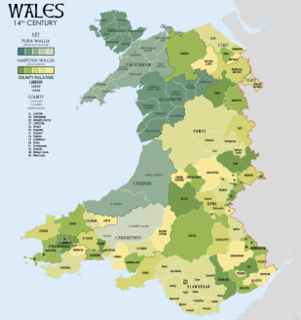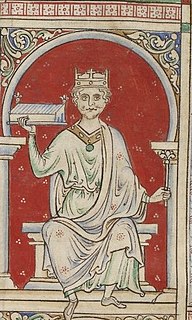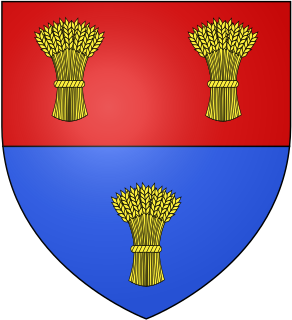
A Marcher Lord was a noble appointed by the King of England to guard the border between England and Wales.
William de Braose, First Lord of Bramber was previously lord of Briouze, Normandy. He was granted lands in England by William the Conqueror soon after he and his followers had invaded and controlled Saxon England.

William de Braose, 3rd Lord of Bramber was a 12th-century Marcher lord who secured a foundation for the dominant position later held by the Braose family in the Welsh Marches. In addition to the family's English holdings in Sussex and Devon, William had inherited Radnor and Builth, in Wales, from his father Philip. By his marriage he increased the Braose Welsh holdings to include Brecon and Abergavenny.

New Radnor is a village in Powys, Wales, to the south of Radnor Forest, and was the county town of Radnorshire.

Steyning is a small rural town and civil parish in the Horsham District of West Sussex, England. It is located at the north end of the River Adur gap in the South Downs, four miles (6.4 km) north of Shoreham-by-Sea. The smaller villages of Bramber and Upper Beeding constitute, with Steyning, a built-up area at this crossing-point of the river.

Loughor Castle is a ruined, medieval fortification located in the town of Loughor, Wales. The castle was built around 1106 by the Anglo-Norman lord Henry de Beaumont, during the Norman invasion of Wales. The site overlooked the River Loughor and controlled a strategic road and ford running across the Gower Peninsula. The castle was designed as an oval ringwork, probably topped by wicker fence defences, and reused the remains of the former Roman fort of Leucarum.
Eardisley Castle was in the village of Eardisley in Herefordshire, England, 11 km north-east of Hay-on-Wye.

Hereford Castle is a castle that used to be in the cathedral city of Hereford, the county town of Herefordshire, England. Founded sometime before 1052, it was one of the earliest castles in England. Hereford Castle was probably destroyed when the Welsh sacked Hereford in 1055, but seems to have been replaced by the following decade. During the civil war of King Stephen's reign, the castle was besieged three times; the garrison surrendered each time and control of Hereford Castle changed hands.
Huntington Castle was situated in the village of Huntingdon in Herefordshire, England, 2½ miles south-west of Kington.
Giles de Braose was Bishop of Hereford from 1200 to 1215.

Walter de Clifford feudal baron of Clifford in Herefordshire, was a Welsh Marcher Lord during the reign of King John (1199-1216).
Huntington is a village in Herefordshire, England on the border with Wales.
Maud de Braose, Lady of Bramber was an English noble, the spouse of William de Braose, 4th Lord of Bramber, a powerful Marcher baron and court favourite of King John of England. She would later incur the wrath and enmity of the King who caused her to be starved to death in the dungeon of Corfe Castle along with her eldest son. In contemporary records, she was described as beautiful, very wise, doughty, and vigorous. She kept up the war against the Welsh and conquered much from them.
Maud de Braose, Baroness Mortimer was a noble heiress, and one of the most important, being a member of the powerful de Braose family which held many lordships and domains in the Welsh Marches. She was the wife of Roger Mortimer, 1st Baron Mortimer, a celebrated soldier and Marcher baron.
Margaret de Braose, Lady of Trim, was an Anglo-Welsh noblewoman, the daughter of Marcher Lord William de Braose, 4th Lord of Bramber and the legendary Maud de St. Valéry, who was left to starve to death by orders of King John of England. Margaret founded a religious house, the Hospital of St. John in her mother Maud's memory. Margaret was the wife of Walter de Lacy, Lord of Trim Castle in County Meath, Ireland, and Ludlow Castle in Shropshire.

The House of Braose was a prominent family of Anglo-Norman nobles originating in Briouze, near Argentan, Orne, Normandy. Members of this family played a significant part in the Norman conquest of England and subsequent power struggles in England, Wales and Ireland in the 11th to 14th centuries.

Brecon Castle is a castle in the town of Brecon, Wales. It was built by the Norman Lord Bernard de Neufmarché in 1093, and was frequently assaulted by the Welsh in 13th and 15th centuries. The castle's ownership changed numerous times. It began falling into ruin when Henry VIII executed the last dukes of Buckingham, who at the time controlled the castle. It was renovated and made a hotel in the early 19th century.

















